Chatfield Family
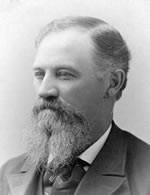
Isaac "I.W." Willard Chatfield
1836-1921
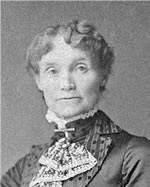
Eliza Ann (Harrington) Chatfield, Isaac's wife
1839-1911
Isaac Willard Chatfield
The gold rush to the Rocky Mountains brought people who wished to prospect in land as well as gold. Isaac "I.W." Willard Chatfield (age 23) and his wife, Eliza Ann Harrington (age 19) traveled by wagon train from Bath, Illinois, to Denver in 1859. Disillusioned by the overcrowded and primitive conditions, plus the lack of viable claim opportunities, the young couple soon moved east to Kansas where they settled on a 160-acre squatter's claim 12 miles north of Fort Scott in Bourbon County. It was there that their first child, Ella (destined to become one of Colorado's most talented sopranos) was born.
With the polarization kindled by the Kansas-Nebraska Act and impending Civil War, Isaac and family fled Kansas, returning to their former home in Bath, Illinois. When war erupted Isaac enlisted in the Union Army's 27th Illinois Infantry, where he rose to the rank of lieutenant in Company "E" before illness forced his mustering out in 1863. It was then that he, accompanied by his wife, daughter Ella, sister Ellen, and Robert Marr Wright (Eliza's cousin) traveled for 8 weeks by ox cart and horses to today's Florence, Colorado, where they eventually settled on a homestead of 160 acres. Isaac raised cattle in Florence, an endeavor quickly bringing him great fortune. By 1870, he had expanded his ranch to 320 acres. In early June, Isaac sold his 320-acre ranch to James McCandles for $5,000 cash, 100 steers at $35 a head, and the Spring Ranch valued at $1,500. The land was subdivided into what is now the town of Florence, honoring McCandles' daughter. Oil was later found nearby.1
In 1871, Isaac moved his family 100 miles due north to Arapahoe County, just south of Littleton, having purchased J.B. Hendy's 160-acre ranch situated at the confluence of the South Platte River and Plum Creek. By 1874, Isaac had expanded his ranch to 720 acres—a huge spread stretching north to encompass the junction of the Platte and Bear Creek River—land Isaac had purchased from Dan Witter, a Denver lawyer and surveyor. During these same several years, Isaac persuaded the Colorado and Central Railroad to establish a station on the narrow-gage spur connecting Littleton to Denver and the East, lucrative and safe for shipping cattle. The small stop at Milepost 14.07 on Chatfield's property was named Chatfield Station. Diversifying, Isaac increased his profits by introducing the practice of growing and shipping potatoes.2
By 1873, Littleton had become a thriving town, a magnificent 35,000-acre agricultural center supporting more than a dozen farms, bounded by the Platte River on two sides, Bear Creek and the foothills. From Bradford Hill could be seen 17 lakes (varying from 10 to 200 acres) formed from ditches cut for water distribution over the last decade. It was during this time that Isaac became a major investor in the Last Chance Ditch Company on the Platte River. The dense cottonwoods lining the ditch netted Isaac and other investors $9.48 per acre.3
Meanwhile, Isaac W. Chatfield continued his cattle, potato, and water operations, increasing his control of the Last Chance Ditch Company to 1/3 by 1878, his stock entitling him to 250 inches of water annually. Even so, by 1879, Isaac's income was tapering; the cattle market was shifting progressively west, and Leadville, just 98 miles southwest by wagon, was rocking the public with news of silver strikes at Iron Hill, Fryer Hills and Carbonate City—a lure that Isaac found impossible to resist. The business opportunities seemed limitless: railroad contracting, grocery store ownership, mining interests, livery and saloon ownership, commercial investment and even politics. He would not return to Littleton but would hold onto his stock in the Last Chance Ditch Company and retain a home on Marion Street in Denver where the children would attend school and vacation with their mother over the summer months.
Isaac then moved the family to Leadville and worked in the railroad contract business. He also acquired shares of two silver mines: the Late Acquisition and the Smuggler #2. Soon, he partnered with Joseph Brinker, Jr. in a grocery store named Brinker & Chatfield. The grocery business proved successful, especially for miners' provisions. Isaac, who often toyed with political aspirations, was elected as a city alderman in 1880. Chatfield and Brinker took on another business partner, Albert Wheeler of New York, in 1881, but this arrangement was dissolved in 1882. A new associate named Wing joined the business in 1882, and the business name changed to Chatfield & Wing.
Isaac and Eliza had nine children: Ella, Clark (died at birth), Elmer, Phil Van Wert (died at age 17), Jacqueline, Charles, Myrtle (died age 3), Grace (died at birth), and Calla. Wert, Myrtle and Grace were all buried in the Littleton Cemetery. Ella became a well-known soprano in Leadville and performed at the local opera house built by Horace Tabor. Elmer worked in his father's grocery store. In 1886, Isaac sold the grocery store to Theodore Blohm Merchandise Company. He returned to cattle raising, buying ranches in Rio Blanco County. Elmer started his own cattle ranch at Emma, Colorado.
Isaac Chatfield and his family eventually moved away from Leadville, settling in Emma, a short distance away from his son Elmer's ranch. Isaac was elected to Colorado's House of Representatives in 1889. However, his bid for state senator in 1896 failed. He returned to Denver in 1899 and later joined the W.E. Moses Realty Company in 1906, becoming the vice president in 1908. Isaac and Eliza celebrated their fiftieth wedding anniversary on May 20, 1908. Eliza died on June 12, 1911, of uterine cancer at the age of 71 in Basin, Big Horn County, Wyoming. On August 30, 1913, Isaac married Sarah Jane (Rooker) Wisenor in Oakland, California. Isaac died on June 14, 1921, at the age of 84, in San Jose, California, the causes of death included arteriosclerosis, chronic cystitis, and other internal maladies associated with the Civil War. He was buried in the GAR veteran's section of the Oak Hill Cemetery in San Jose.4
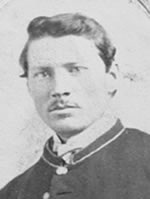
Private Edward L. Chatfield
1863
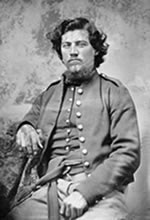
Lieutenant Isaac W. Chatfield
1862
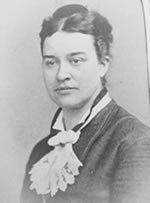
Anna (Bates) Chatfield, Edward's wife
1845-1916
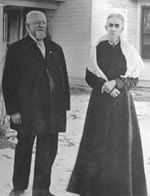
Edward L. Chatfield and Anna (Bates) Chatfield, c. 1913 (Littleton Museum)
Edward Livingston Chatfield
It was during the spring of 1874 that Isaac's 1st cousin from Kankakee, Illinois, arrived in search of land, 38 year-old Isaac greeting 32-year-old Edward Livingston Chatfield at the Chatfield Station. Edward and Isaac would have had much to talk about, other than land purchases, both having been Union soldiers who had fought major battles during the Civil War. Isaac's first experience in war had come on April 7, 1862, on a Mississippi River island south of Cairo—Island Number 10—a huge Union victory routing 7,000 Confederate troops. His next battle came on the New Year in Murfreesboro—below Nashville—the Battle of Stones River. This tragic, brutal, 3-day standoff resulted in 31,000 casualties North and South, after which Isaac was hospitalized in Nashville with what had become a chronic kidney-bladder infection. It was this illness that soon forced Isaac's retirement.
Edward's first battle came at the Chickasaw Bayou against Vicksburg in December, 1862, a portion of which he described in his December 29, 1862 diary entry:
The heaviest of battles is raging, and the wounded are coming in very fast this afternoon. Our soldiers were all cut to pieces. It was the worst sight I ever have seen. Our boys are being slaughtered by the hundreds.5
Edward fought three more major battles before being captured on June 11, 1864, following the Battle of Brice's Crossroads near Baldwyn and Guntown, Mississippi. This led to ten grim months of imprisonment at Camp Sumter (Andersonville), Camp Lawton (Millen), and Florence Prison before Edward managed to escape.
Nine years had since passed, enabling Edward to heal while entertaining thoughts of having his own farm, raising his own cattle, and eventually marrying. Littleton seemed ideal. And there was one additional attraction offered by the young community: the rarified clean air. For years, Edward's mother had suffered from acute spells of asthma, the doctors offering no cures other than suggesting that the family consider moving to a place near Denver where the air was said to be far healthier. For this reason, Edward dutifully represented his parents in the May 11, 1874, purchase of a land parcel offered by Mr. Bagley Gouse, located in Section 27, Township 3, Range 70 of Jefferson County. The newly titled owner would be Edward's father: Nathan Stoddard Chatfield, husband of Margaret Prudentia (Herrick) Chatfield.6
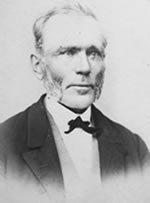
Nathan Stoddard Chatfield, Edward's father
1816-1885
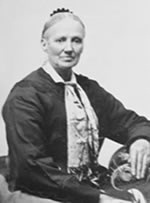
Margaret Prudentia (Herrick) Chatfield, Edward's mother
1818-1887
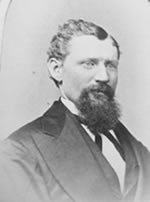
Edward Livingston Chatfield, Isaac's 1st cousin
1842-1924
But land of his own was also on Edward's agenda, his 67-year-old father having sold off some of his Kankakee land assets to finance the purchase. Thus, on August 12, 1874, Isaac sold to Edward a portion of his Arapahoe County land, a 2,700 by 675 foot rectangle of land situated in the south-west quarter of Section 31, Township 5, Range 68 West. The slice of land included a 1,400 foot strip of the South Platte River—a section that now serves as the spillway to the Chatfield State Reservoir. Before Edward returned to Kankakee, it's likely that he and Isaac agreed on plans to enlarge Edward's foothold, beginning with the southern half of lots 1 and 2 of the same section, a purchase that would be consummated in April, 1875. But, five years would pass before the Chatfields of Kankakee would move to Littleton.7 On January 30, 1879, Isaac sold to a man named Frank Caley the land he had not already sold to Edward.8
It was when Isaac moved to Leadville—in the early spring of 1879—that Edward and family undertook their move to Littleton and settled on the land they had purchased from Isaac back in 1874, land facing the Chatfield Station. Edward's first action was to negotiate a trust deed with the Colorado Mortgage & Investment Company, assuring him water rights to his 1874 land purchase.9 From that point forward, the Chatfields from Kankakee became progressively well- known and established in Littleton. Not everyone in the family came immediately. The 1879 arrivals included Edward and his wife, Anna (Bates) Chatfield, his parents, his uncle and aunt (Margaret's brother and sister-in-law, William A. Herrick and Jeanette {Nichol} Herrick of Trumbull County, Ohio who purchased the ranch adjacent to Edward's land) and Edward's two youngest siblings—the 6th and 7th born: Charles Henry Chatfield (23) and Mary Margaret Chatfield (20). Within three years, Charles returned to the Kankakee farm given to him by father, Nathan. Others from the family eventually to arrive in Littleton included the 3rd, 4th, and 5th born siblings, William Stoddard Chatfield (31)10, Isaac Newton Chatfield (29), and James Herrick Chatfield (27). David Avery Chatfield, the 2nd born, had died in his Kankakee home at the age of 18, likely due to disease, a tragedy that occurred while Edward was held captive at Camp Sumter—Andersonville's notorious Civil War prison.
As was the case for most folks in the area, Edward did not arrive in Littleton with his pockets deep in money; a steady income was hard to come by. Hardened by his war experiences, and suffering from recurrent bouts of malaria, he nevertheless remained industrious, diligent, sturdy, and community-minded. An astute reader, he was willing to learn whatever he must to make his own way. He was a hero to many, a remarkable survivor of this nation's most deadly war, his legend gradually spreading—likely assisting him from time to time. Littleton was in a period of rapid growth. It wasn't long before Edward spotted an Arapahoe County notice seeking applicants to serve as local road overseer—responsible for ensuring that the roads were fit for wagon passage, the low points filled, the ruts smoothed, and the bridges repaired after annual freezes—important services assuring safety to the community and facilitating commerce.
Scanning the job description, Edward must have immediately recognized that his experiences as a Civil War wagoner demanded similar work on a daily basis, bridge construction and repair commonplace for him while at Vicksburg. But experience was not enough. The position required that the candidate also have financial backing—surety protecting county equipment at the disposal of the man selected. Edward turned to his father for help; his father agreed and asked Mr. Shellabarger, a new friend, for additional support. Shellabarger evidently knew both men well enough to trust them. Nathan (68) had been a highly successful farmer and was a skilled mason with many talents—a man who had built his own house, cleared roads, dug wells, diverted water, and single-handedly installed elaborate irrigation systems. If thirty-seven-year-old Edward ran into difficulties, his father would be there to help. Edward submitted his application along with the required evidence of surety. Several weeks later, to his great joy, Edward was selected as the Platte District Road Overseer for Arapahoe, County. The announcement came in early April, 1880.11 It was a safe bet for Mr. Shellabarger. For the next 10 years, when not working his ranch, Edward capably served as the county road overseer, his reputation for fairness and competency spreading.
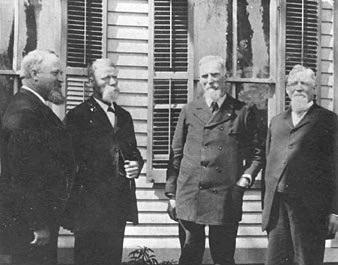
Chatfield brothers left to right: James Herrick, Isaac Newton, William Stoddard, and Edward Livingston.
c.1911
On October 17, 1891, the City of Littleton granted Edward a franchise to lay the city water pipes and construct and operate the city water works for a period of twenty-five years.12 It was a terrific job, one demanding most of Edward's time, one requiring the help of more than one competent man. And for this reason, Edward called upon his recently widowed brother, James, who had rushed to Littleton in a desperate 1888 move in hopes that the clean rarified Colorado air would cure the "consumption" (tuberculosis) suffered by his dear wife Annie.
By May, 1892, Edward had become a member of the Littleton Board of Trade and was elevated to a director within nine months. A respected rancher and farmer in the community, people turned to Edward when in need of fine cows or information about the worthiness of the latest Durham wheat. He was also a capable businessman. As a wheat farmer, he bagged his best seeds and sold them on the open market. As a trader of beef, he helped underwrite and oversee the operation of the Littleton Canning Company, facilitating wide distribution of canned meat throughout the west. He also leased portions of his ranch to breeders of Percherons—exceptionally strong horses that were bred specifically to pull heavy loads. The breeders, in turn, charged substantial fees for the valued registered animals to usher mares. Extending his water business, Edward became a principal stockholder, and eventually the treasurer, of Littleton's profitable—and wryly named—Last Chance Ditch Company, #2—the successor to Cousin Isaac's company. Beyond this, for many years, Edward served the Platte area as one of its prominent election judges.13 Edward contributed to Littleton in many countless ways. He served with his brothers, James and Newton, as a member of the Littleton Cemetery Association. Active from its inception commemorating services for the Union in the Grand Army of the Republic, Edward was elected Post Commander of the John C. Fremont Post No. 83 in 1895.14
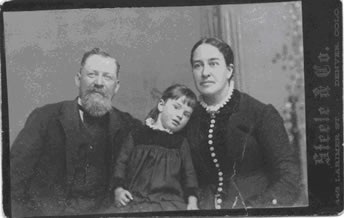
Edward, Edaline, Anna
c.1886
If it was Edward's exceptional digestive system that enabled him to survive the famishing conditions of the Confederate war prisons, it was that very same biology that eventually killed him at the age of 82, his body severely overweight, his brain disabled by the savagery of multiple strokes. The citizens of Littleton had seen it coming as early as 1915 when he was seventy-three years old: he was forgetful, failing to pay his recurring debts, not showing up to scheduled meetings. The problems grew increasingly worse until a July 19, 1917, competency hearing found Edward to no longer be mentally competent.15 It was then that control over the Chatfield Ranch passed on to Chatfield's daughter, Edaline Chatfield Rhea and her husband Bernie. The Rheas maintained the ranch as best they could for three years, but the bills continued to pile up, making a close-out sale the only option. The Chatfield Ranch was sold to Charlie Newby of Arvada, the brother-in-law of E.E. Oviatte of Littleton, on February 27, 1920.16 The Rheas moved Edward to Sawtelle, the Old Soldier's Home that was near their own home in Long Beach, California. Chatfield died on December 3, 1924, at the age of 82. Edaline had his body returned Littleton—the place with rarified clean air that Edward called home for 41 years. Edward was buried next to his wife Anna in the family plot of the Littleton Cemetery.
Prior to her death in 1964, Edaline donated Edward's three Civil War diaries to the Littleton Historical Museum where they remain safeguarded to this day. Upon her death, she passed on Edward's many Civil War letters to her cousin, Margaret Chatfield McCarty, co-author of The Chatfield Story.
James Herrick Chatfield
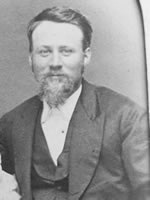
James Herrick Chatfield,
Edward's brother
1851-1919
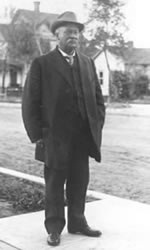
James H. Chatfield, c.1913
As mentioned earlier, James moved to Littleton in 1888 in a desperate attempt to save his wife Annie, who was seriously ill with "consumption." Annie lost her battle with the fatal disease in late February, 1889; she was only 33, a tragedy leaving James (37) with two children to care for and a new home to manage. Fortunately, both Edward and their sister Mary Margaret Chatfield were in the position to help. Mary tended the children: Edward Livingston Chatfield, Jr. (13) and "Nelly" Margaret Chatfield (4). James was bright and industrious, talents needed by a growing community. By October of 1889, James was functioning as a public notary, conducting business in real estate loans, and arranging sales as a very successful real estate agent from his office at 416 Main Street. By the summer of 1891, he had become a judge—Littleton's first justice of the peace. He remained as the justice of the peace for Precinct 1 until he passed away in 1919. Judge Chatfield performed his first marriage ceremony during the week of August 2.17 A year later to the month, James was courting a young lady who turned out to be a 6th cousin, Mary Elmina Dickinson. Mary was living at the time just 340 miles southwest of Littleton in the small mountain community of Rico, Colorado. James married Mary Dickinson on September 5, 1892, and the couple established residence at the foot of Main Street (458 Main) just down the street from James's place of business. James and Mary Chatfield had one daughter, Elmina, who, upon graduation from the University of California at Berkeley, taught school in Littleton for several years. It was about this time that James was appointed as member of the Littleton Cemetery Association, eventually elevating to the position of superintendent by 1896, serving that organization for decades to come.18
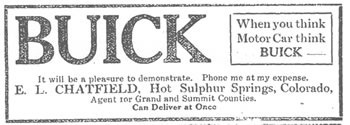
About 1896, James's only son, Edward Livingston Chatfield, Jr., (named after his uncle Edward) traveled to Sulfur Springs (now Hot Sulfur Springs, 103 miles northwest of Littleton) seeking relief from inflammatory rheumatoid arthritis. The natural hot mineral springs there seemed to help him, thought by the Ute Indians as "Big Medicine." The springs had been acquired from the Utes by the Byers family who started the Rocky Mountain News in Denver. Edward stayed and became employed by the local livery stable. It wasn't very long before he became a full partner in The Metropolitan Stables. Later, Edward bought out his partner and became full owner. Foresighted as he was, Edward traveled to Denver in 1915, and purchased a 4 cylinder c-25 touring Buick from McFarland Auto Company and received in turn the Buick dealership for 3 counties: Grand, Summit, and Jackson.
After about two hours instruction (never having ridden in a car, let alone driven one) he left for the 100 mile trip over the Berthoud Pass west of Denver. This was a one-way wagon road. From that time on from the teens and twenty's, Dad Buicks went over all roads and all kinds of weather, running a livery service. When a doctor had to go on an emergency or the telephone repairman had to go to repair a broken telephone line, it was one of Dad's Buicks that went. –Edward H. Chatfield, 197519
It was during his mid-sixties that problems with edema and blood circulation weakened James so severely that when his wife Mary died in 1919, he was forced to move to Hoquiam, Washington, to be cared for by his daughter, Nellie (Chatfield) Driver. James never returned to Littleton, his death attributed to "dropsy" on April 20, 1919.
Nellie Margaret, like her brother, suffered from debilitating arthritis, requiring surgical removal of her toes in order to walk. And walk she did, backpacking with her husband throughout California's High Sierras every fall. Starting as a mail clerk in Bell, California, she was appointed to serve as the Postmaster for the Bell Gardens Post Office in the late 1940's.
Isaac Newton Chatfield
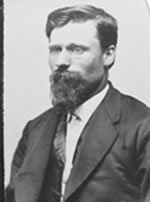
Isaac Newton Chatfield, Edward's brother
1849-1926
"Newton," as his family called him, with his wife Elizabeth "Lizzie" Mead and their three children, Eunice, Leslie, and Laura, moved to Littleton in 1890 where they purchased a grocery store on Main Street. Forty-one-years-old when he arrived, he operated his store for the next ten years, his familiar ads running regularly: The Best Grocery — Chatfield's is the place to buy groceries. Cheap for Cash. –Potatoes, Apples, Dried Fruit, Pickles, and fine Canned Goods—A fresh line of Goods will be kept in stock. Goods delivered to all parts of the city. Give us a call. I.N. Chatfield, No. 2, Culp Block, Main Street.20 Newton became a community leader and a trustee of the Littleton Presbyterian Church. In 1900, Newton spotted an opportunity to serve as the caretaker of Colorado Agricultural College's Chemistry Department. He applied, interviewed, and was selected for the job that he would proudly serve through the age of 72.
Mary Margaret Chatfield
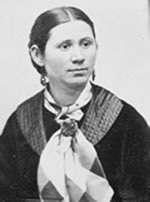
Mary Margaret Chatfield, Edward's sister
1859-1925
A dutiful daughter, as a young adult she cared for her parents, Nathan and Margaret, from 1879 to 1887. A caring sister and aunt, she mothered James's two children for three years following the 1889 death of his first wife, Annie Mary. With James's guidance, she bought and sold property, accumulating her own independent financial means. On March 19, 1895, 36-year-old Mary wed 24-year-old Noah Shepardson, the son of a Union Civil War surgeon—and the younger brother of Otis Shepardson, who was listed as a ranch hand for Edward and Anna in the 1880 Federal Census. Mary and Noah had three children: Charles, Margaret and Marcia. Charles, their firstborn became a dean at Texas A & M University in adulthood. President Eisenhower subsequently appointed him to the Federal Reserve Board on March 17, 1955. A graduate of Colorado State College of Education (now University of Northern Colorado) Margaret taught middle school in the Fort Collins area for 40 years, retiring in 1963. Beloved by students, teachers, and parents, she was honored by the Poudre School District Board of Education naming an elementary school for her.21 Marcia died at an early age after moving east to study nursing.
Honoring the Chatfields of Illinois, early pioneers of Littleton, the Chatfield family name has become an integral part of the community's fabric. Chatfield Avenue at Platte Canyon Road marks the entrance to the 1879 Chatfield Ranch. The world-class Chatfield State Park and Recreation Area preserves a rich and diverse ecology while safeguarding the community from floods, daily controlling 1,400 surface acres of water. Chatfield High School, one of the community's fine schools, helps prepare our nation's youth for tomorrow's world. A host of local businesses also operate under this proud name.
Bibliography
- Chatfield, Edward H., From Horses to Horsepower! Or, 25 Years as a Buick Dealer, (Unpublished speech presented to the Model T Club of So. California), 1975
- Juza, Susan M., The Chatfield Family History, (Unpublished Genealogical History), c. 1995
- Littleton City Directory, 1905.
- Littleton Museum. Vertical File. Biography: Chatfield
- Littleton (Colo.) Independent. The Littleton Independent Publishers, 1888-
- McCarty, Terry M. and Margaret, The Chatfield Story, Civil War Letters and Diaries of Private Edward L. Chatfield of the 113th Illinois Volunteers, North Charleston, South Carolina: CreateSpace, 2009-2010
- Sevenau, Catherine & Clemens, Gordon, A Chatfield Family History (Isaac W. Chatfield & Eliza A. Harrington Family Lines), California: Unpublished monographs of the Chatfield family, 2010
Endnotes
1 Sevenau & Clemens, A Chatfield Family History
2 Ibid.
3 Rocky Mountain News, "A Day In Littleton," Feb 9, 1873, page 4
4 Sevenau & Clemens, Ibid.
5 McCarty, et. al., The Chatfield Story, p. 42
6 Jefferson County Records, Volume E, page 42.
7 McCarty, ibid., p. 452; Arapahoe County Land Records, Book A-15 Page 27
8 Jefferson County Land Records, Vol. 15, page 78, book 2, page 189. (Property description: W2 NE4 SE4 NW4 N2 SE4 NE4 SW4 Sect 30-5-68)
9 Arapahoe County Land Records, Book A52 Pg 423 (April 22, 1879)
10 By 1880, William Stoddard Chatfield had purchased a residence on Main Street, visiting regularly, but remained a Kankakee resident and businessman for the rest of his life. (McCarty, Ibid., 463)
11 Littleton Independent, April 7, 1880
12 Littleton Independent
13 McCarty, Ibid., 453
14 Littleton Independent
15 Colorado Transcript,Jefferson County, July 19, 1917
16 Littleton Independent
17 Ibid.
18 Ibid.
19 Chatfield, E.H.,From Horses to Horsepower,page 1; Buick Ad fromLittleton Independent
20 Littleton Independent,17 Oct 1891
21 Juza, Susan M.,The Chatfield Family History,126
22 Words of acknowledgement and appreciation are extended to Margaret Chatfield McCarty, Gordon Clemens, and Catherine (Clemens) Sevenau who selflessly read and reread this material, offering suggestions along the way that added vitally to the content.
Portrait photo credits
- Portraits of Isaac Willard Chatfield and Eliza Anna Harrington courtesy of Gordon Clemens and Catherine (Clemens) Sevenau.
- Portraits of Edward Livingston Chatfield, Nathan Stoddard Chatfield, Margaret Prudentia Herrick Chatfield, Anna Bates Chatfield, James Herrick Chatfield, Isaac Newton Chatfield, Mary Margaret Chatfield courtesy of Terry M. McCarty and Margaret Ann Chatfield McCarty
- Littleton Museum photographs are so designated. To order copies, contact the museum at 303-795-3950
Compiled by Terry M. McCarty
Updated March 2021 by Phyllis Larison